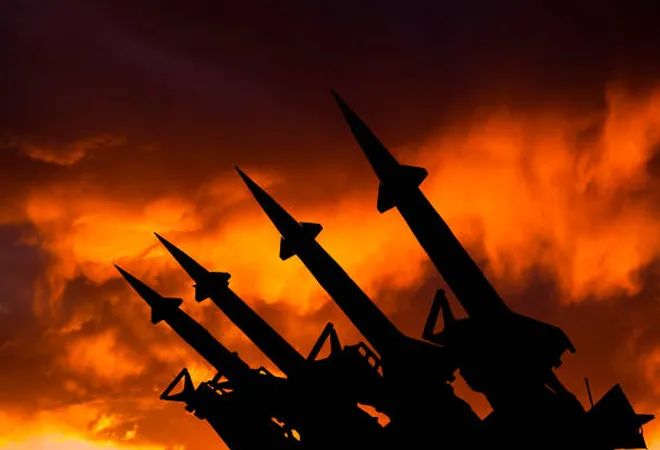
On 13 June 2022, the Stockholm International Peace Research Institute (SIPRI) shared its
annual global nuclear weapons arsenal inventory assessment. The assessment broadly noted that there had been a marginal decrease in the nuclear inventory of nine nuclear-armed states. Still, over the coming decade, this inventory is expected to grow. Currently, there are an estimated 12,705 nuclear warheads in total, out of which about 9,440 were in military stockpiles for potential use.
Table 1: World nuclear forces, January 2022
| Country |
Nuclear weapons inventory |
| China |
350 |
| France |
290 |
| India |
160 |
| Israel |
90 |
| North Korea |
20 |
| Pakistan |
165 |
| Russia |
5,977 |
| United Kingdom |
225 |
| United States |
5,428 |
Source: SIPRI Yearbook 2022
For Southern Asia, the assessment notes that all three countries—India, China, and Pakistan—appear to be amidst an expansion of their nuclear arsenal. Moreover, they are also deploying different kinds of delivery systems. Specifically, SIPRI highlighted that China is substantially expanding its arsenal and constructing over 300 new missile silos. Current estimates show that China has 350 operational warheads, 248 land-based ballistic missiles, and 72 sea-based ballistic missiles. It also has 20 nuclear gravity bombs. Beijing is also activating its nuclear triad based on land, sea-based missiles, and nuclear-capable aircraft.
As far as India is concerned, it has approximately 160 warheads, and New Delhi is also modernising its arsenal by developing
canisterisation and Multiple Independent Re-entry Vehicle technology to take its delivery systems to the next level. On the other hand, Pakistan is slightly ahead with 165 warheads and is exploring ways to upgrade its delivery systems as part of its ‘full spectrum deterrence posture.’
Current estimates show that China has 350 operational warheads, 248 land-based ballistic missiles, and 72 sea-based ballistic missiles.
SIPRI’s assessment gives an impression that Southern Asia is in the midst of an arms race, and India is rapidly expanding its nuclear arsenal. While this is perhaps true, the nuclear dynamics of this region are inextricably linked to the larger global scenario, which is today characterised by two interlinked aspects: An uncertain fate of the United States–Russia arms control cooperation and the bleak prospect of nuclear disarmament. Both these factors shape India’s threat perception.
The Ukraine conflict and the resultant US-Russian tensions have ruled out any substantial progress on the arms control front shortly. Russian officials’ repeated references to
nuclear weapons during the ongoing Ukraine conflict have only worsened matters. However, the US-Russia bilateral consensus over arms control had unravelled even before the Russian hostilities in Ukraine. Both had
withdrawn from the Intermediate-Range Nuclear Forces Treaty in 2019 and subsequently, from the
Open Skies Treaty. These moves demonstrated their unwillingness to advance negotiations on any arms control instrument and to retain existing bilateral or multilateral avenues of cooperation.
In 2021, Russia and the US proceeded quickly to salvage one last bilateral nuclear arms control arrangement, the New Strategic Arms Reduction Treaty. Presidents Vladimir Putin and Joe Biden agreed to
extend this treaty by five years, which was due to expire in February that year. This was a significant development yet, inconsequential in altering the larger dynamics, as the subsequent deterioration in Russia-US ties showed.
Trust deficit levels between Moscow and Washington remain high to envision any progress on arms control negotiations. Sergey Lavrov, Russian Foreign Minister, has
stressed that if Ukraine goes nuclear, Russia “cannot but react to this real danger.” US officials share Russian scepticism. As Mallory Stewart, US Assistant Secretary of State for Arms Control, Verification, and Compliance
noted recently, “With
illegal invasion of Ukraine and their continued, horrific 17th century activities, it’s very hard to figure out how we can sit and think that our diplomacy will be taken seriously on that side.”
Russia and the US proceeded quickly to salvage one last bilateral nuclear arms control arrangement, the New Strategic Arms Reduction Treaty.
This air of uncertainty over arms control is directly feeding not just the Russian and American drive to diversify and refine their nuclear arsenal but also Beijing, as the SIPRI report has noted. In the last decade, China has advanced its nuclear triad capabilities—from historically strong land-based intercontinental ballistic missiles to inducting Julang-2 submarine-launched ballistic missiles and planned introduction of the Xian H-20 strategic stealth bomber. These developments are, in turn, driving India’s nuclear modernisation efforts.
The major powers’ nuclear modernisation is coupled with their efforts to develop offensive capabilities in domains like cyber and space. However, these domains have no effective arms control agreement as such. It can be argued that major powers are benefitting from the lack of any arms control framework in these domains, particularly Russia and China in cyberspace. These dynamics, therefore, are posing newer challenges to deterrence stability. Besides, any contemporary arms control will inevitably entail levels of intrusive inspection, which will not be acceptable to any of the major powers. This makes the prospects of any arms control agreement, nuclear or otherwise, even slimmer.
The TPNW’s conditions reflect those of the Nuclear Non-Proliferation Treaty and the Comprehensive Test Ban Treaty, which put the onus of nuclear non-proliferation on non-nuclear powers without commensurate responsibility on nuclear powers.
The major powers’ scepticism on arms control is also reflected in the bleak outlook for nuclear disarmament. In February 2021, the United Nations-negotiated Treaty on the Prohibition of Nuclear Weapons (TPNW) entered into force. This treaty prohibits participation in any nuclear weapon-related activities, thereby trying to grapple with the issue of prestige associated with nuclear weapons. However, none of the nuclear powers has acceded to it, meaning the TPNW essentially forbids these activities for countries that do not even have nuclear capabilities.
The TPNW’s conditions reflect those of the Nuclear Non-Proliferation Treaty and the Comprehensive Test Ban Treaty, which put the onus of nuclear non-proliferation on non-nuclear powers without commensurate responsibility on nuclear powers. This makes the TPNW irrelevant to disarmament and the normative issues associated with nuclear weapons.
Perhaps, only an escalation or a crisis, similar to the Cuban Missile Crisis of 1962, may break this cycle and trigger interest in arms control and non-proliferation. Alternatively, even the realisation on the part of the major powers that what you can do to others can also be done to you—sort of a mutually assured destruction logic of deterrence—can potentially compel them to try their hand in institutionalising the nuclear restraint through an agreement This will create an enabling condition for strategic stability in Southern Asia.
Keerthana Rajesh Nambiar is a Research Intern at ORF.
The views expressed above belong to the author(s). ORF research and analyses now available on Telegram! Click here to access our curated content — blogs, longforms and interviews.



 On 13 June 2022, the Stockholm International Peace Research Institute (SIPRI) shared its
On 13 June 2022, the Stockholm International Peace Research Institute (SIPRI) shared its  PREV
PREV


